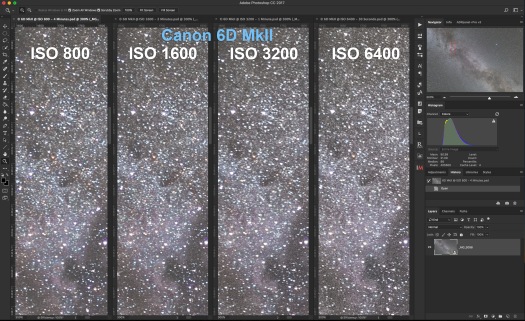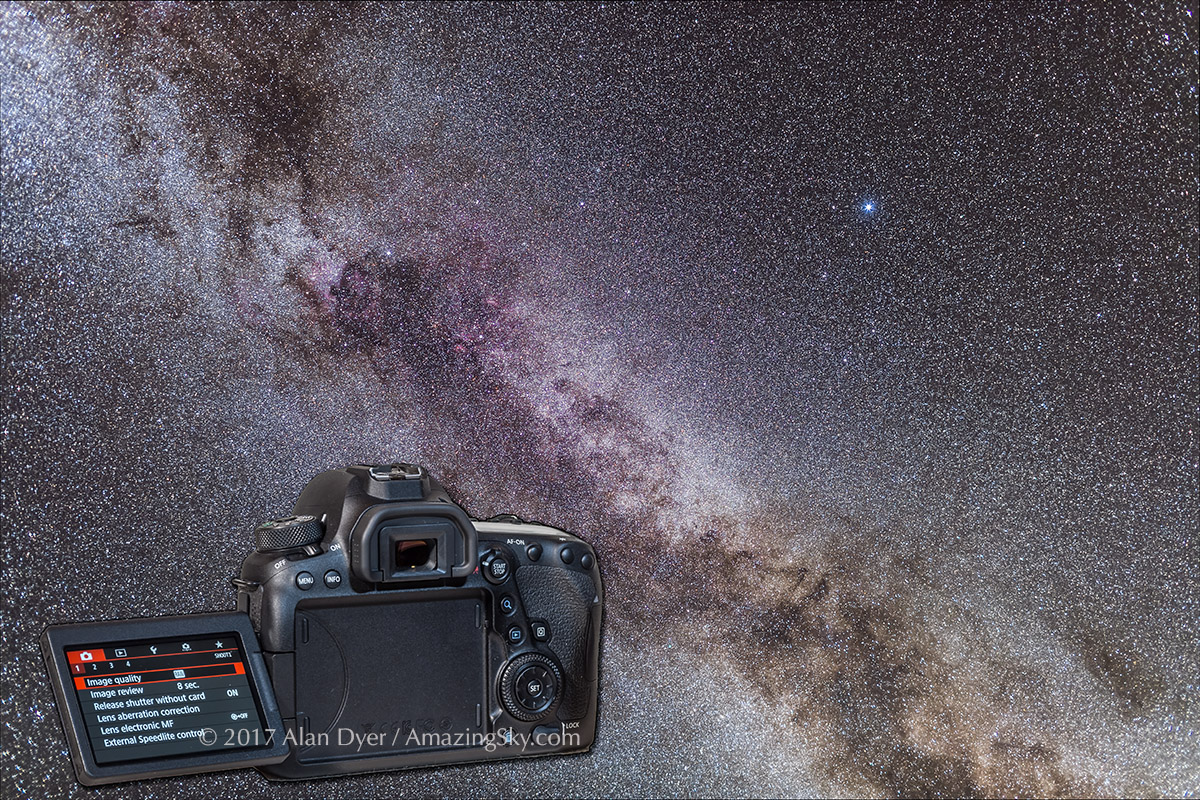
Following up on my earlier tests, I compare the new Canon 6D MkII camera to earlier Canon full-frame models in long, tracked exposures of the Milky Way.
A month ago I published tests of the new Canon 6D MkII camera for nightscape images, ones taken using a fixed tripod in which exposures usually have to be limited to no longer than 30 to 60 seconds, to prevent star trailing.
Despite these short exposures, we still like to extract details from the dark shadows of the scene, making nightscape images a severe test of any camera.
I refer you to my August 9, 2017 blog Testing the Canon 6D MkII for Nightscapes for the results. The 6D MkII did not fare well.
Here I test the 6D MkII for what, in many respects, is a less demanding task: shooting long exposures of deep-sky objects, the Milky Way in Cygnus in this case.
Why is this an easier task? The camera is now on a tracking mount (I used the new Sky-Watcher Star Adventurer Mini) which is polar aligned to follow the rotation of the sky. As such, exposures can now be many minutes long if needed. We can give the camera sensor as much signal as the darkness of the night sky allows. More signal equals less noise in the final images.
In addition, there are no contrasty, dark shadows where noise lurks. Indeed, the subjects of deep-sky images are often so low in contrast, as here, they require aggressive contrast boosting later in processing to make a dramatic image.
While that post-processing can bring out artifacts and camera flaws, as a rule I never see the great increase in noise, banding, and magenta casts I sometimes encounter when processing short-exposure nightscape scenes.



• Canon 6D MkII (2017)
• Canon 6D (2012)
• Canon 5D MkII (2008)
Note that the 5D MkII has been “filter-modified” to make its sensor more sensitive to the deep red wavelengths emitted by hydrogen gas, the main component of the nebulas along the Milky Way. You’ll see how it picks up the red North America Nebula much better than do the two off-the-shelf “stock” cameras. (Canon had their own factory-modified “a” models in years past: the 20Da and 60Da. Canon: How about a 6D MkIIa?)
I shot at four ISO speeds typical of deep-sky images: 800, 1600, 3200, and 6400.
Exposures were 4 minutes, 2 minutes, 1 minute, and 30 seconds, respectively, to produce equally exposed frames with a histogram shifted well to the right, as it should be for a good signal-to-noise ratio.
Noisy deep-sky images with DSLR cameras are usually the result of the photographer underexposing needlessly, often in the mistaken belief that doing so will reduce noise when, in fact, it does just the opposite.
The above set of three images compares each of the three cameras at those four ISO speeds. In all cases I have applied very little processing to the images: only a lens correction, some sharpening, a slight contrast and clarity increase, and a slight color correction to neutralize the background sky.
However, I did not apply any luminance noise reduction. So all the images are noisier than what they would be in a final processed image.
Even so, all look very good. And with similar performance.
All frames were shot with Long Exposure Noise Reduction (LENR) on, for an automatic dark frame subtraction by the camera. I saw no artifacts from applying LENR vs. shots taken without it.
The 6D and 6D MkII perhaps show a little less noise than the old 5D MkII, as they should being newer cameras.
The 6D MkII also shows a little less pixelation on small stars, as it should being a 26 megapixel camera vs. 20 to 21 megapixels for the older cameras. However, you have to examine the images at pixel-peeping levels to see these differences. Nevertheless, having higher resolution without the penalty of higher noise is very welcome.



The new 6D MkII shows very similar levels of noise to the 6D, perhaps improving upon the older cameras a tad.
Because images are well-exposed (note the histogram at right), the 6D MkII is showing none of the flaws of its lower dynamic range reported elsewhere.
That’s the key. The 6D MkII needs a well-exposed image. Given that, it performs very well.

The lead image at the very top is a final full-frame image with the Canon 6D MkII.
As such, based on my initial testing, I can recommend the Canon 6D MkII (and plan to use it myself) for deep-sky photography.
Indeed, I’ll likely have the camera filter-modified to replace my vintage yet faithful 5D MkII for most of my deep-sky shooting. The 6D MkII’s tilting LCD screen alone (a neck, back, and knee saver when attached to a telescope!) makes it a welcome upgrade from the earlier cameras.
The only drawback to the 6D MkII for deep-sky work is its limited dark frame buffer. As noted in my earlier review, it can shoot only three Raw files in rapid succession with Long Exposure Noise Reduction turned on. The 5D MkII can shoot five; the 6D can shoot four. (A 6D MkIIa should have this buffer increased to at least 4, if not 8 images.)
I make use of this undocumented feature all the time to ensure cleaner images in long deep-sky exposures, as it produces and subtracts dark frames with far greater accuracy than any taken later and applied in post-processing.
I hope you’ve found this report of interest.
With the 6D MkII so new, and between smoky skies and the interference of the Moon, I’ve had only one night under dark skies to perform these tests. But the results are promising.
For more tips on deep-sky imaging and processing see my pages on my website:
Ten Steps to Deep-Sky Processing
Thanks and clear skies!
— Alan, September 7, 2017 / © 2017 Alan Dyer / amazingsky.com


Hey Alan,
I am having a very hard time finding H-alpha filters for 6d mkii. Do you have any suggestions on where can I find any if available? Also, I dont want to astro modify my camera as its my main camera for other purposes. Thanks!
Hello, I see Astronomik (who you have no doubt checked as they offer a wide selection of clip-in filters) do not have any for the 6D MkII. You could buy a 2-inch filter to screw into a camera adapter. But unless you modify the camera for H-a sensitivity there’s no point using an H-a filter. Or any narrowband nebula filter for that matter.
Hello Alan. Do you have any further thoughts on the 6D Mark II for deep sky astrophotography? I am considering buying this camera after reading your great in-depth reviews. I presently have a 7D which I find limiting. Thanks Terry
Hi Terry, the 6D MKII works well for deep sky where you can give the image as much exposure time as it needs. It will be less noisy than the 7D. It is in nightscapes where much of the scene ends up underexposed where it falls down. The R mirrorless cameras, especially the R6, are far better for ISO invariant performance equal to Sony or Nikon. But the 6D MkII is similar to the R6 for noise in well exposed deep sky shots. But mirrorless cameras have a brighter live view for ease of framing and focusing. I’m working on a test of the R6 for astrophotography. It is impressive. I use it and the Ra exclusively and rarely use the 6D MkII, and will be selling it. Hope this helps!
Thanks, Alan. Your comments are very helpful.
Thanks a lot for the great reviews, Alan! They add valuable information to your recent S&Tel article. A stupid question: What does “underexposure” exactly mean? I use a 450Da for DeepSky-focal and expose quite short but long enough that sky background is visible in all rgb channels (i mean that the histogram curves are not clipped at the left side). Is this the right exposure time? Thanks in advance!
Hello! Yes, exposing so the histogram is to the right is best. Even to the point of the sky being too bright and the histogram mostly centred. I find that produces images with the least noise and artifacts. I never see walking noise and banding in my images.
Great article as well as the tips for deep-sky images. I’m new to this so and am curious about setting ISO on my 6D mark II. In terms of the best noise control, would you recommend one 30s exposure with a lower ISO or three 10s exposures taken in succession at higher ISO, then stacked?
It takes 4 exposures at ISO 1600, say, to equal the noise level of one shot at ISO 800. Longer exposures at lower ISOs are better and more time efficient, but are not always practical. But for tracked and guided deep-sky where you can shoot as long as you like, shoot at lower ISOs, then shoot as many of those as you can and stack them. Always shoot for as long as the sky brightness will allow. Don’t underexpose, especially with the 6D MkII.
I am having trouble currently that maybe you could help me with Alan. I was so set on buying a upgrade as i just sold my old cannon(1100D) and wanted to take the leap on a 6D Mkii for my first Full-frame investment. The main purpose i was actually going to use it for was a long distance hike on The California West Coast primarily doing Landscape photography with a Zeiss Distagon 21mm 2.8 and Astro-photography with a Rokinon 24mm 1.4. I am glad i didn’t buy my lenses just yet as i would of been stuck with a Canon LF lens mount but instead i count myself lucky i am in the position of asking for help.
As you are obviously experienced with night-time shoot’s could you point me in the direction of a better full-frame alternative? My budget is around £2000 as i have been saving for a while. It’s a shame that the 6DMkii isn’t holding up well with the many reviews i have read on night-time shoot’s as i was sold on the sealed weather protection that the mkii has. Any advice for other full-frame alternatives would be sincerely appreciated!
I should of noted that I am looking at doing Astro-Landscape photography for my type of Astro shooting. Many Thanks
Hi, As long as you expose the 6DMkII well it’s fine. It’s in underexposed shadows where it suffers. My camera of choice for nightscape use is the Nikon D750. It has a much better and brighter live view with a greater zoom factor for more precise focusing. But it is 2 or 3 years old and is likely to be replaced soon with a newer model, though will it be better? Hope this helps.
Another invaluable post, Alan! Also, your “Ten Tips for Deep-Sky Images” is excellent advice for anyone starting into astrophotography.